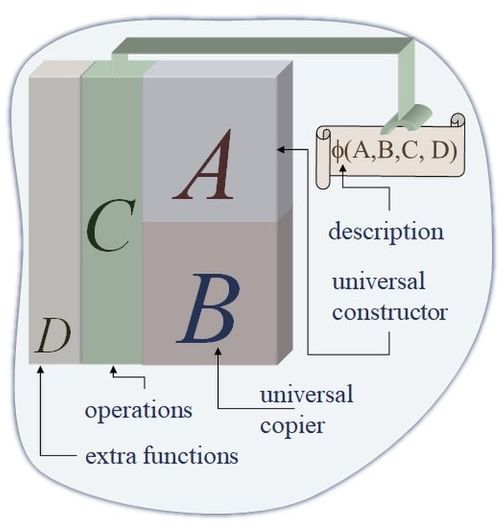Von Neumann's Universal Constructor as a Metaphor for Inefficient Organizations
April 27, 2025The Universal Constructor, invented by John Von Neumann, is a fascinating cellular-automata machine that can self-replicate and evolve over time. It does this via a very clever instruction-copying system, that mirrors how DNA works in biological life.
Here's a diagram of the basic components of the machine:

A quick rundown of components:
- A: The constructor. This can create new structures as described by a set of instructions.
- B: The copier. This copies instruction tapes.
- C: The operating system. This component ingests the instruction tape (φ(...)) and coordinates activites between A, B and D.
- D: extra functions. Any extra stuff that the machine does when it isn't replicating.
For the purposes of this post, it's not necessary to understand the precise workings of each component. The important thing to know is that (A), (B) and (C) are "core" components that are used purely for replication, and (D) encapsulates any behavior of the machine that is not related to replication.
Why is "extra functions" so small? #
A funny thing about this diagram is that (D) is quite small compared to the other components. This indicates that the machine is mostly concerned with replication, and (D) is an afterthought. Of course, this is just a choice in visual representation- the size of this component is not fixed, and it could be larger and more complex than the other components in practice. But I think this image provides an interesting visual metaphor for inefficient organizations.
When organizations evolve #
There's a well-known process that occurs as organizations grow and evolve over time, where the original purpose of organization can get lost. TheZvi has written about this in his series on immoral mazes. It looks something like this:
- You start an organization to do thing X.
- As the organization grows, more and more resources are consumed in the logistics of growing and managing the organization.
- You look around and realize the vast majority of resources are being spent on not-X.
You've found yourself in a universal constructor, where (D) is dwarfed in size by the other components!
The metaphor isn't perfect (organizations don't perfectly replicate, for starters!), but I think this is a useful way to think about the balance of resource allocation in organizations. If you lead or work at an organization, it may be valuable to ask - what is the balance of (D) to (A, B, C), and is it ideal for what the organization is trying to accomplish?